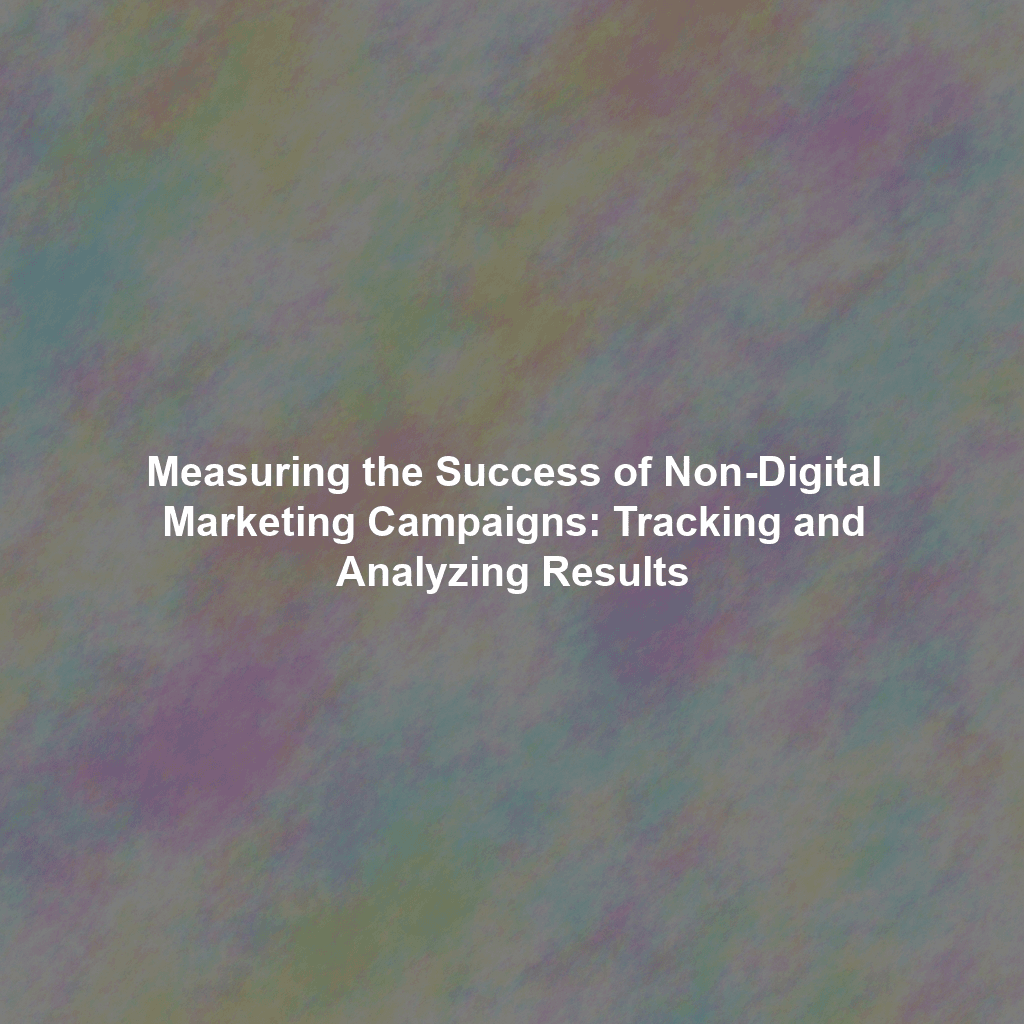In today’s data-driven world, measuring marketing success is paramount. While digital campaigns offer readily available metrics, tracking the impact of non-digital marketing initiatives requires a more nuanced approach. This guide provides a detailed exploration of methods for tracking and analyzing the results of your offline marketing efforts, enabling you to optimize performance and demonstrate a tangible return on investment (ROI).
Why Measuring Non-Digital Marketing Matters
It’s easy to assume that non-digital marketing is inherently harder to measure. While it presents unique challenges, neglecting to track its performance can lead to wasted resources and missed opportunities. Accurate measurement allows you to:
- Optimize Campaign Performance: Identify what works and what doesn’t, allowing you to refine future campaigns for better results.
- Justify Marketing Spend: Demonstrate the value of your offline efforts to stakeholders and secure future budget allocations.
- Understand Customer Behavior: Gain insights into how your target audience responds to different offline channels.
- Integrate with Digital Efforts: See how non-digital and digital marketing work together to create a cohesive customer experience.
Tracking Methods for Non-Digital Campaigns
Several methods can be employed to track the effectiveness of your non-digital marketing campaigns. The key is to choose the techniques that are most appropriate for your specific goals and target audience.
Unique Offer Codes and URLs
Assign unique promotional codes or shortened URLs to different marketing materials, such as print ads, flyers, or direct mail pieces. When customers use these codes or visit the designated URLs, you can track which campaign generated the response.
Example: A print advertisement for a local restaurant includes the code “SUMMER15” for a 15% discount. By tracking the usage of this code, the restaurant can determine the effectiveness of the print ad.
Trackable Phone Numbers
Use different phone numbers for each campaign. Call tracking software can then provide data on the number of calls received from each number, allowing you to attribute leads and sales to specific offline initiatives.
Example: A radio advertisement promoting a car dealership includes a unique phone number. The dealership can track the number of calls received on that number to gauge the radio ad’s performance.
Surveys and Feedback Forms
Include questions in customer surveys or feedback forms to ask how they heard about your business. This provides direct insight into the effectiveness of your marketing efforts.
Example: A retail store asks customers at checkout, “How did you hear about our store?” with options like “Flyer,” “Newspaper ad,” “Word of mouth,” etc.
Point-of-Sale (POS) Data Analysis
Analyze your POS data to identify trends and patterns that correlate with specific marketing campaigns. Look for increases in sales or specific product purchases following the launch of an offline initiative.
Example: A bookstore promotes a new author with in-store signage and a local newspaper ad. Analyzing POS data can reveal whether sales of that author’s books increased following the campaign launch.
Foot Traffic Analysis
For brick-and-mortar businesses, tracking foot traffic can be a valuable indicator of campaign success. Use foot traffic counters or manual observations to monitor changes in customer visits following a marketing push.
Example: A clothing store distributes flyers in a nearby residential area. By monitoring foot traffic in the days following the flyer distribution, the store can assess the campaign’s impact.
Manual Tracking and Observation
Sometimes, simple observation and manual tracking can provide valuable insights. For example, you can track the number of people who visit a booth at a trade show or count the number of entries received in a contest promoted through flyers.
Example: A company participates in a local job fair. They can manually track the number of resumes collected at their booth to gauge the effectiveness of their presence at the event.
Analyzing the Results: Turning Data into Insights
Collecting data is only the first step. The real value lies in analyzing the information to extract actionable insights. Consider the following when analyzing your non-digital marketing data:
Calculate ROI
Calculate the return on investment (ROI) for each campaign by comparing the cost of the campaign to the revenue generated. This will help you prioritize the most effective channels.
Formula: ROI = (Revenue – Cost) / Cost * 100
Identify Key Performance Indicators (KPIs)
Define specific KPIs that align with your campaign objectives. Examples include leads generated, website traffic, sales conversions, or brand awareness. Track these KPIs over time to measure progress.
Compare Campaign Performance
Compare the performance of different non-digital campaigns to identify which strategies are most effective for your target audience and business goals.
Segment Your Data
Segment your data based on demographics, geographic location, or other relevant factors to gain a deeper understanding of customer behavior and preferences.
A/B Testing for Offline Materials
A/B test different versions of your offline marketing materials (e.g., flyers, advertisements) to see which performs better. This could involve testing different headlines, images, or calls to action.
Integrating Non-Digital and Digital Marketing
The most effective marketing strategies often involve a seamless integration of non-digital and digital efforts. Use offline channels to drive online engagement, and vice versa. For example, a direct mail campaign can include a QR code that directs recipients to a landing page on your website.
Conclusion
Measuring the success of non-digital marketing campaigns is essential for optimizing performance, justifying marketing spend, and understanding customer behavior. By implementing the tracking methods and analysis techniques outlined in this guide, you can gain valuable insights into the effectiveness of your offline efforts and demonstrate a tangible return on investment. Don’t underestimate the power of blending both digital and non-digital strategies for a comprehensive and successful marketing approach.
 Skip to content
Skip to content

